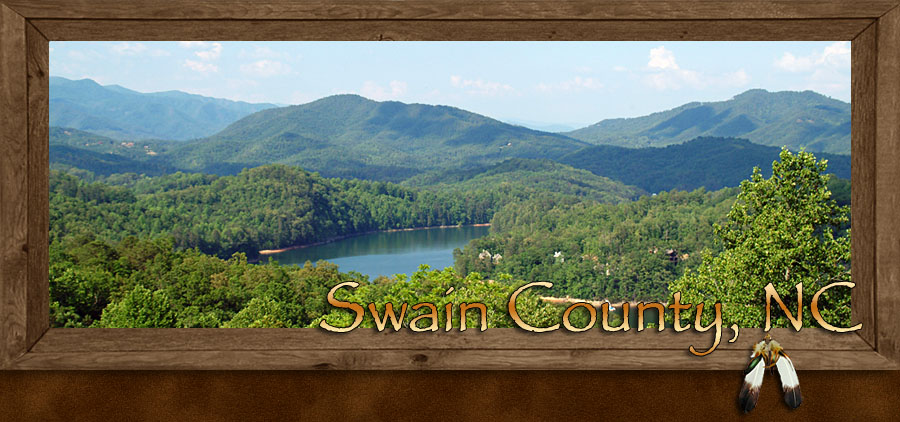
| Home | Sign up for Highlander Newsletter | Order Free Brochures and & More Info | Purchase Unique Gifts, Books, Photos & Artwork |
Bryson City • Cherokee • Qualla Boundary • Oconaluftee Village • Swain County
Western North Carolina • Great Smoky Mountain National Park
Travel • Real Estate • Horseback Riding • Lodging • Restaurants • White Water and Outdoor Adventure
|
In the mid-1500s Hernando De Soto’s quest for gold brought his Spanish army to the Blue Ridge Mountains, no significant amounts of gold were found and no settlements were ever established.
To the earliest colonial settlers the Appalachian and Blue Ridge Mountains were nearly impenetrable, yet brave and adventurous souls wandered deep into the mountain’s interior, mostly as hunters and fur traders. Over two hundred years had passed since De Soto’s expedition when two naturalists William Bartram and Andre’ Michaux and his son bravely ventured into the deep mountains on separate expeditions in order to investigate the plants and animals of the southwestern Blue Ridge Province. It wasn’t until 1809 that the first white settlements started appearing in what is now as the Swain County region, a land the Cherokee had possessed for several hundred years.
The Cherokee also known as the Principle People at the time of the their contact with white settlers, were a considerably accomplished native people of Northern America with over 200 Cherokee towns throughout the central southeast. They often lived in harmony through trade and treaty with the new settlers and its government though they did fought alongside the British against the new Americans. Due to trading goods with the Europeans in exchange for the Cherokee fur commodities, most Cherokee choose to assimilate the new European arrivals, these material goods and influence toward prospers lifestyles encouraged many of the people. A Cherokee named Sequoyah found it essential to create a written language for their people to preserve the future of their society believing education was the key to their long-term success with the new arrivals. That all changed in the early 1830’s when and abundance of gold was discovered in the Blue Ridge Mountains causing President Jackson to make a decree for the removal and possession of all properties of the Cherokee. This act lead to the infamous “Trail of Tears,” where thousand of Cherokee were rounded up and forced to the Oklahoma Territory where many died along the way.
Many of the Cherokee people hid out deep in the mountains and joined other Cherokee who lived in the remote corner of what is now Swain County. Their resistance to leave eventually led to the securing of the Cherokee Reservation or more properly referred to as Qualla (Native American) Boundary.
Today Swain County is one of the most popular vacation destinations in the Blue Ridge, Smoky Mountains region.
Bryson City
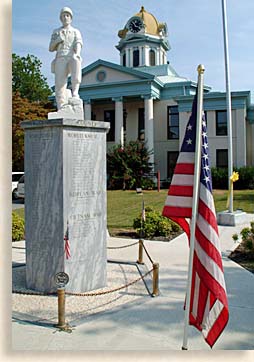 The county seat of Swain County is Bryson City, a small mountain town that began its roots in 1809 with the coming of the first white settlers, and a remote town that grew to prominence when the railroad arrived in 1884. Bryson City was officially formed in 1881 and incorporated in 1887. The Greek revival courthouse built in 1907 and stands as a symbol of strength to the community. On the front lawn is an impressive memorial dedicated to fallen heroes, the monument displayed with local pride of heritage.
The county seat of Swain County is Bryson City, a small mountain town that began its roots in 1809 with the coming of the first white settlers, and a remote town that grew to prominence when the railroad arrived in 1884. Bryson City was officially formed in 1881 and incorporated in 1887. The Greek revival courthouse built in 1907 and stands as a symbol of strength to the community. On the front lawn is an impressive memorial dedicated to fallen heroes, the monument displayed with local pride of heritage.
Bryson City is a beautiful town filled with historical turn of the century architecture, set against a backdrop of the Great Smoky Mountains rising high above the town’s northern horizon. The Gateway to the Great Smoky Mountain National Park is located in Swain County is located near Bryson City. The popular Tuckasegee River runs thru the heart of Bryson City, the river is a favorite location for anyone that loves fly-fishing.
Bryson City’s historic railroad depot lying at the center of its shopping and dining district, provide mountain folk entertainment with each blow of the train whistle announcing the arrival of carloads of tourists and guest all aboard the mountain scenic railroad. A visit to Bryson City is like a step back to simpler times, a celebration of accomplishment and propriety to this remote region of the Great Smoky Mountains.
Bryson City is a homespun community whose local historical museum depicts the heritage and lifestyle of the mountain folks and the courage that was required by their ancestors to forged a new world out of a land thought to be untamable by most early American. Local shopping, dining, lodging and recreation along with other services and opportunities in Bryson City and throughout Swain County make for a wonderful vacation destination for the whole family. Bryson City truly lives up to its motto, “Uncrowded, Unhurried, Unspoiled, Uncommon.”
There’s a wealth of history, sights, natural wonders and fun things to do in and around Bryson City in Swain County, allow plenty of time to enjoy it all.
Cherokee; Qualla (Native American) Boundary
One of the greatest gifts of Swain County is the ever-growing town of Cherokee in the Qualla Boundary of North Carolina. An effort to evade the United States Army in the late 1830’s lead many of the Cherokee people to retreated deep into the remote region of what we know today as the Smoky Mountains. Due to an unfortunate turn of events between the Cherokee and the Army, a Cherokee named Tsali, his oldest son and his brother in-law were executed due to a skirmish resulting in military death. This surrender and execution freed the Cherokee people of further harassment by the Army. Today as well as then, these men are considered to be heroes. Their lives contributed to the present existence of the Eastern Band of the Cherokee in the Smoky and Blue Ridge Mountain region. This natural setting for the Cherokee People provides the means for the expression and lifestyle unique to this society of Native Americans. Their customs and contribution to history has enriched our Nation.
Most Americans take pride in our being a young strong Nation, yet we’re not so young after all. Native Americans are the key to our past. Archeologists date their presence in the Americas back 12,00 thousand years. Mound Builders of the Mississippian Culture occupied much of the southeastern and mid-western United States. Their advanced mound cities demonstrated the supremacy of these ancient societies through organization of individual governments, agriculture, trade, religious beliefs and customs. The Mound Builder were the predecessors of many of the Native Americans we know today.
The Cherokee People have been known throughout Early American history as the Civilized People, The preservation of the Cherokee culture along with other Native American cultures that have survived the ages are the cornerstone of our countries own past. A past that was stripped from our commonly known history books due to European genocide, disease and the expulsion of Native Americans from their homelands.
The town of Cherokee is a wonderful place to visit for people of all ages. There you’ll find both the gateway to North Carolina’s Great Smoky Mountains and the trailhead to the renowned scenic Blue Ridge Parkway. The community of Cherokee like all Native American Boundaries are self-governed by its tribal leaders. The experience you’ll find here in Cherokee is totally unique, their history, their customs and hospitality are that of a people who are accustomed to accepting the rights and beliefs of others. The fact is that they are the true blood right Americans and we are their welcomed guests still resonates from their sense of warm hospitality.
The Museum of the Cherokee Indian located along the Oconaluftee River is an enlightened experience. Its state-of-the-art displays tells the story of the early Native American’s and their encounters with the first Europeans to the time of the Cherokee People domination of the central southeastern United States beginning in the late 15th Century thru to the beginning of the 19th Century. The museum tour concludes with the mass exodus of the Cherokee from their homelands to the Oklahoma Territory along the “Trail of Tears. Many Cherokee date their relationship with this mountainous region to their origins of creation continuing to trade with this region for millenniums before their repopulation of the territory in the 1500’s. Possible warfare contributed to their migration from the Great Lakes region back to the southern United States prior to the 16th Century. The Museum of the Cherokee Indian begins with a beautiful animated film reliving their creation story and their prehistoric roots in this region of North America. Their struggle for survival remains as an example of an American success story in the land the Cherokee People have always cherished. The museum’s state-of-the-art displays are both informative and quite entertaining.
The fact that some descendents Cherokee believe tribal ancestors have been connected with this mountainous region since the days of the great mastodon hunts. A replica of a mastodon vertebra found in the local area is displayed in the museum. This theory has possibility, and in fact is supported by archeological findings. There’s a long abandon village site between the towns of Cherokee and Bryson City. Along the banks of the Tuckasegee River and bordered by highways U.S. 19 and U.S. 74 is the Kituwah Village. This is considered to be a very sacred site dating back possibly 10,000 years. The Blue Ridge Highlander finds this to be a very significant tale; the Highlander intends on sharing this story with its readers the site and its known history.
Next door to the Museum of the Cherokee Indians are the Cherokee Fairgrounds. The fairgrounds have an outdoor theater with stadium seating, which is covered from the back of the stage to the back row of seats, keeping out the elements of sun 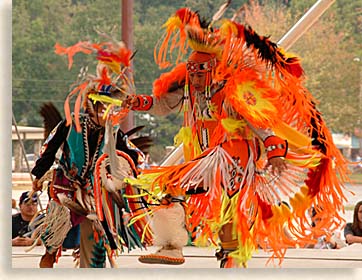 and rain. Here special events and festivals with live performances depicting tribal customs are old thru dance, storytelling and symbolic crafts.
and rain. Here special events and festivals with live performances depicting tribal customs are old thru dance, storytelling and symbolic crafts.
Tiers sweep up the slope of the hills, forest surround the horizon; stage is centered front row, a time capsule is about to unfold. “Unto these Hills,” is an outstanding performance by a cast of 130 performers, telling the story of the Cherokee People and the Sacred Fire. Performances include elaborate costumes, song and dance with colorful stage settings. The outdoor theater for the live performance is hidden above the fairground behind a forest-covered hill. Over six million people have seen this great performance; no trip to Cherokee is complete without this experience, you will be moved!
The town of Cherokee also has the Oconaluftee Indian Village an actual replica of a 1750’s Cherokee village. Here daily life, arts, crafts and customs can be viewed and enjoyed, an experience that’s set back in time when the Great Cherokee Nation ruled these mountains and southeastern valleys.
The town of Cherokee has shops upon shops, dining throughout, lodging amusements parks and so much more. A popular and well-established addition to the town of Cherokee is an electronic gaming casino drawing large numbers of visitors daily throughout the year. A 15-story 600-room hotel, conference center and 6 restaurants make this a serious gaming facility.
Within the Qualla Boundary is the world of outdoor recreation you can fly fish for rainbow or brown mountain trout along the rushing water of Oconaluftee River. Oconaluftee River also offers white water rafting with Class IV and V rapids. Hiking, mountain biking, horseback riding and camping are also available throughout the region.
The Qualla Boundary offers spectacular waterfalls, scenic drives and the occasional sighting of black bears; natural wonders and majestic beauty will make your trip a memorable one. There’s much to do and see in Cherokee North Carolina, so make sure you take enough time to enjoy it all.
Great Smoky Mountain National Park
Swain County is the essence of mountain beauty and is located at the southern entrance to the Great Smoky Mountains National Park in North Carolina. Swain County has many attributes and natural wonders such as lakes, rivers, waterfalls, whitewater rafting, fishing, hiking, horseback riding, mountain biking, scenic drives, camping and historic towns to mention a few.
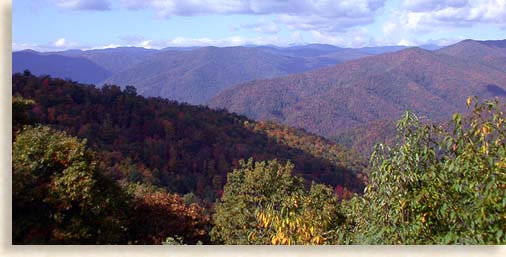
The Great Smoky Mountains National Park along the northern border of Swain draws millions of visitors a year to the heights of the Eastern United States. The scenic views, the trails, rivers, plants, animals and displays of early mountain culture offer visitors a unique perspective of a life few have had the privilege to experience. The seasons offer a display of varying beauty that captivates the senses. Spring ushers in a flora covering of budding trees, wildflowers, dogwood blossoms, mountain laurels, azaleas and rhododendrons. Summer turns the mountains into a mysterious world of rainforest and mists coining the popular phrase “Smoky Mountains.” Autumn brings visitors in abundance to witness nature’s colorful palette and bold brush strokes against a canvas of mountains and valleys. Winter is the white solitude of snow capped mountains and ice sculptures clinging to boulders and rock face with hibernating bears and fauna in a sleeping winter wonderland. The pass over New Found Gap in the Great Smoky Mountains National Park is beaming with life and unparallel vistas offering outdoor activities you can enjoy throughout the year.
Fly-fishing, hiking and the occasional sighting of black bears thrill visitors with tales to be told for years to come. The infamous Appalachian Trail crosses the mountain gap traversing nearly the entire length of America’s favorite National Park. The Great Smoky Mountain National Park is an experience you must take, not only once but several times.
Fontana Lake and Dam
Fontana Lake and Dam is a crystal blue oasis located in western Swain County with a lake reservoir 29 miles in length bordering the Great Smoky Mountains to the north. Water sports and recreation on Western North Carolina largest lake and tallest damn in the Eastern United States offer fun and enjoyment for the whole family. Camping, fishing, boating and hiking along the shoreline can fill the day and night. Everyone who comes to Fontana Lake will witness the significance and grandeur of Fontana Dam. This mammoth dam is equivalent to a 50-story skyscraper, the highest dam in the eastern United States. From the observation deck atop the dam’s visitor center you can look down onto the Little Tennessee River below as it winds through the narrow mountains on its westward journey.
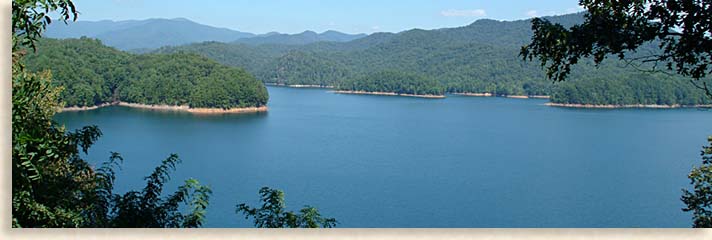
Tsali Recreation Area
Tsali Recreation Area on Fontana Lake is considered a Mecca for horseback riding, mountain biking and hiking with a four-loop trail system offering a variety of landscapes. Alternating trails keep the horseback and bikers separated, you don’t want to spook equestrian riders. A rustic campground offers 42-campsites with no hookups provided. Two boat launches are available for flat-water paddling and motor boating with great fishing for walleye, black bass, crappie, catfish and white bass. The name Tsali, a noted Cherokee leader was given to the recreation area to honor his life along with the life of his oldest son and brother-in-law. A skirmish between soldiers and the Tsali party after the Cherokee removal ended in military death. Their surrendering and execution of these Cherokees set about and agreement that allow the remainder of the Cherokee people hiding in these mountains the right to remain in their beloved homeland.
Nantahala River Gorge
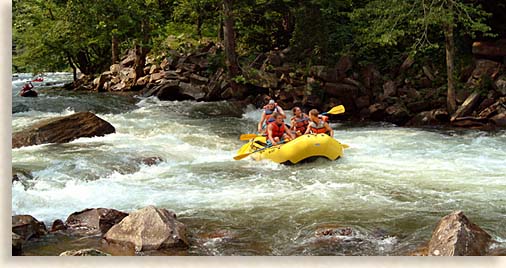 Looking to get a little wet and yell at the top of your lunges? A thrill of a lifetime awaits you when you raft the white waters down the Nantahala River Gorge in southwestern Swain County. This whitewater world finds its roots high in the mountains of the Nantahala National Forest. The popular whitewater river is a favorite for rafters, kayaks and canoeist, funyaks and slalom adventures from March to November. Outfitters offer skilled guided rafting tours by the boatloads. You can take a scenic drive thru the Nantahala River Gorge and enjoy the beauty of this deep rainforest or pull off at overlooks or picnic areas and watch the fun of those floating down the river, you’re also likely the see a scenic train tour on the other side of the riverbank.
Looking to get a little wet and yell at the top of your lunges? A thrill of a lifetime awaits you when you raft the white waters down the Nantahala River Gorge in southwestern Swain County. This whitewater world finds its roots high in the mountains of the Nantahala National Forest. The popular whitewater river is a favorite for rafters, kayaks and canoeist, funyaks and slalom adventures from March to November. Outfitters offer skilled guided rafting tours by the boatloads. You can take a scenic drive thru the Nantahala River Gorge and enjoy the beauty of this deep rainforest or pull off at overlooks or picnic areas and watch the fun of those floating down the river, you’re also likely the see a scenic train tour on the other side of the riverbank.
Scenic Drive - Blue Ridge Parkway
For other scenic drives you can pickup the Blue Ridge Parkway at the base of the Smoky Mountains just outside the town of Cherokee North Carolina. The Blue Ridge Parkway follows the backbone of the Blue Ridge Mountains for roughly four hundred miles arriving at the Shenandoah National Park in Virginia. On the short menu you can take an hour or more drive along the Blue Ridge Parkway and witness some of the most spectacular scenery on earth with trails and points of interest along the way. The drive back along the parkway is just as visually exciting. The highest overlook on the Parkway is just east of Swain County between the town of Waynesville and Asheville, North Carolina.

Another scenic and more casual drive in Swain County is the Road to Nowhere. This eight-mile drive is off the beaten path and offers a more intimate view of Swain County and the Smoky Mountains. Due to funding the road was never completed yet definitely worthy of the venture. If you just happen to have a blown up inner tub, bring it with and you can splash down Deep Creek just off the Road to Nowhere, a fun activity to kids of all ages.
The abundance of beauty, history and outdoor adventure are legendary in Swain County and all waiting for your personal enjoyment and discovery. Come to the high country you’ll be glad you came.
| Qualla Native American Boundary | Nantahala River Gorge | Rivers, Creeks and Streams |
| Lake Fontana | Fishing in Swain County | Nantahala National Forest |
Bryson City • Cherokee • Qualla Boundary • Oconaluftee Village • Swain County
Western North Carolina • Great Smoky Mountain National Park
| Adventure on the Nantahala River, Rafting, Kayaking, Rappelling, Horseback Riding, Christian Retreats |
|
Sign up for the Blue Ridge Highlander Newsletter, Messages from the Mountains
to find out first about our new feature stories, road trips and special offers
Your e-mail addresses will not be sold or given away to anyone.
Privacy Policy
Interested in your business being on the Highlander, click here...
Let our visitors tell you about the Highlander...
Click the feathers to go to the Highlander site
map...

of C. Wayne Dukes and Sherry Bell Dukes. 1996 - 2014, except where otherwise stated. All rights reserved, reproduction,
downloading, and/or duplication of any sort is strictly prohibited, all violations will be prosecuted. Legal Policy.
If you have any questions, or comments, regarding this site, e-mail the Highlander.
